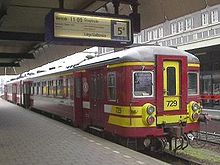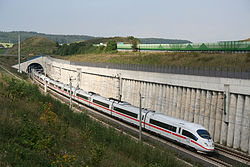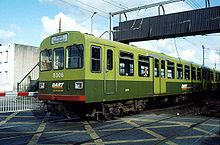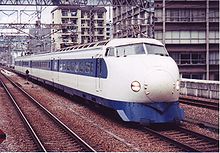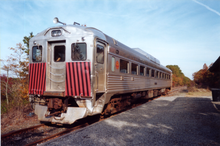- Multiple unit
-
This article is about Multiple Units vehicles. For the train control technology, see Multiple-unit train control.
Multiple unit trains Subtypes Electric multiple unit
Diesel multiple unit
Push–pull trainTechnology By Country The term multiple unit or MU is used to describe a self-propelled carriages capable of coupling with other units of the same or similar type and still being controlled from one driving cab. The term is commonly used to denote passenger trainsets consisting of more than one carriage. Single self-propelling carriages (also called railcars, rail motor coaches or railbuses) can be referred to as multiple units if capable of operating with other units.
Multiple units are classified by their power source and are of two main types: electric multiple unit (EMU) or diesel multiple unit (DMU). Diesel-powered units may be further classified by their transmission type: diesel-electric (DEMU), diesel-mechanical (DMMU) or diesel-hydraulic (DHMU).
Locomotives utilising multiple-unit train control are not multiple units.
Contents
History
Multiple-unit train control was first used in Electric Multiple Units in the 1890s. This allowed electrically-powered rapid transit trains to be operated from a single driving position. Early users of such multiple units include the Liverpool Overhead Railway (the first multiple units) and Chicago's South Side Elevated Railroad (the first units to use a low-voltage control system).
Steam-powered ancestors
The United Kingdom and France (for example Voiture État à 2 étages) had many examples of push-pull steam trains, or autotrains and railmotors on branch lines which include at least partial control of a steam locomotive from a remote cab. These provided many of the operational benefits of a multiple unit, although none incorporated any form of electrical/electronic multiple-unit train control.
Design
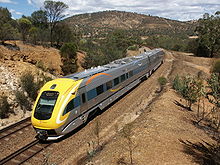 The Transwa Prospector DEMU capable of up to 200 km/h provides a passenger service between Perth, Western Australia and the mining town of Kalgoorlie
The Transwa Prospector DEMU capable of up to 200 km/h provides a passenger service between Perth, Western Australia and the mining town of Kalgoorlie
Most MUs are powered either by traction motors, receiving their power through a live rail or overhead wire (EMU), or by a diesel engine driving the wheels through a gearbox or hydraulic transmission (DMU). Diesel-electric multiple units (DEMUs) have a diesel engine that drives a generator producing electricity to drive traction motors in a similar fashion to a diesel-electric locomotive.
A multiple-unit trainset has the same power and traction components as a locomotive, but instead of the components being concentrated in one carbody, they are spread out on each car that makes up the set. In many cases these cars can only propel themselves when they are part of the set, so they are semi-permanently coupled. For example, a DMU might have one car carry the prime mover and traction motors, and another the engine for head end power generation; an EMU might have one car carry the pantograph and transformer, and another car carry the traction motors.
It is not necessary for every single car in an MU set to be motorized. Therefore MU cars can be motor units or trailer units. Instead of motors, trailing units can contain supplementary equipment such as air compressors, batteries, etc.; trailer cars may also be fitted with a driving cab.
In most cases, MU trains can only be driven/controlled from dedicated cab cars. However, in some MU trains, every car is equipped with a driving console, and other controls necessary to operate the train, therefore every car can be used as a cab car whether it is motorised or not, if on the end of the train. An example of this arrangement is the NJ Transit Arrows.
Examples
Virtually all rapid transit rolling stock, such as ones used on the New York City Subway, the London Underground, and other subway systems, are multiple-unit trainsets, usually EMUs. Most trains in the Netherlands and Japan are MUs, making them suitable for use in areas of high population density.
Many high-speed rail rolling stocks are also multiple-unit trainsets, such as the Japanese Shinkansen and the latest-generation German InterCityExpress ICE 3 high-speed trains. A new high-speed MU, the AGV, was unveiled by France's Alstom on February 5, 2008. It has a claimed service speed of 360 km/h.[1]
Freight multiple units
A new concept is to use the multiple unit idea for freight traffic, such as carrying containers or for trains used for maintenance. The Japanese M250 series train has four front and end carriages that are EMUs, and has been operating since March 2004. The German CargoSprinter have been used in three countries since 2003.
Comparison to locomotive-hauled trains
Advantages
Multiple units have several advantages over locomotive-hauled trains:[citation needed]
- Energy efficiency — MUs are more energy-efficient than locomotive-hauled trains. They are more nimble, especially on gradients, as much more of the train's weight (sometimes all of it) is carried on power-driven wheels, rather than the train having to haul the dead weight of unpowered hauled coaches. In addition, they have a lower weight-per-seat value than a locomotive-hauled train since they do not have a bulky locomotive that does not itself carry passengers, but contributes to the total weight of the train. This is particularly important where train services make frequent stops, since the energy consumed for accelerating the train increases significantly with an increase in weight.
- Higher acceleration rate — Because of the energy efficiency, higher power-to-weight ratio and higher adhesive-weight-to-total-weight ratio values, MUs generally have higher acceleration ability than locomotive-type trains and are favored in urban trains and subway (metro) systems for frequent start/stop routines.
- No need to turn locomotive — Most MUs have cabs at both ends, resulting in quicker turnaround times, reduced crewing costs, and enhanced safety. The faster turnaround time and the reduced size (due to higher frequencies) as compared to large locomotive-hauled trains, has made the MU a major part of suburban commuter rail services in many countries. MUs are also used by most rapid transit systems. However, this is no longer a problem for locomotive-hauled trains due to the increasing use of push-pull trains.
- Makeup can be changed mid-journey — MUs may usually be quickly made up or separated into sets of varying lengths. Several multiple units may run as a single train, then be broken at a junction point into shorter trains for different destinations.
- Reliability — As there are multiple engines, or motors, the failure of one engine does not prevent the train from continuing its journey. A locomotive-drawn train typically has only one power unit, whose failure will disable the train. However, some locomotive-hauled trains may contain more than one power unit and thus be able to continue at reduced speed after the failure of one.
- Axle load — Multiple units have lighter axle loads, allowing operation on lighter tracks, where locomotives may be banned. Another side-effect of this is reduced track wear, as traction forces can be provided through many axles, rather than just the four or six of a locomotive.
- Easy and quick driving — Multiple units generally have rigid couplers instead of the flexible ones often used on locomotive-hauled trains. That means that brakes or throttle can be more quickly applied without an excessive amount of jerk experienced in passenger coaches.
- Allowance for accurate performance calculations for timetabling purposes — In a locomotive-hauled train, if the number of cars is changed in order to meet the demand, acceleration and braking performance will also change. This calls for performance calculations to be done taking the heaviest train composition into account. This may sometimes cause some trains in off-peak periods to be overpowered with respect to the required performance. When two or more multiple units are coupled, train performance remains almost unchanged. However, in locomotive-hauled train compositions, using more powerful locomotives when a train is longer can solve this problem.
Disadvantages
Multiple units do have some disadvantages as compared to locomotive-hauled trains:[citation needed]
- Maintenance - It may be easier to maintain one locomotive than many self-propelled cars.
- Safety - In the past it was often safer to locate the train's power systems away from passengers. This was particularly the case for steam locomotives, but still has some relevance for other power sources. A head-on collision or level-crossing accident involving a multiple unit (with passengers potentially right at the front of the train) is likely to result in more casualties than one with a locomotive (where the heavy locomotive would act as a 'crumple zone').
- Easy replacement of motive power - If a locomotive fails, it can be easily replaced with minimal shunting movements. There would be no need for passengers to evacuate the train. Failure of a multiple unit will often require a whole new train and time-consuming switching activities; also passengers would be asked to evacuate the failed train and board another one.
- Efficiency - Idle trains do not waste expensive motive power resources. Separate locomotives mean that the costly motive power assets can be moved around as needed and also used for hauling freight trains. A multiple-unit arrangement would limit these costly motive power resources to use in passenger transportation.
- Gangways - It is difficult to have gangways between coupled sets, and still retain an aerodynamic leading front end. Because of this fact, frequently there is no passage between high-speed coupled sets. In such instances more crew may be required, so that ticket inspectors, for example, can be present in all of them. This leads to higher crew costs and lower utilization of crew resources. In a locomotive-hauled train, one single crew can serve all the train regardless of the number of cars in the train provided limits of individual workload are not exceeded. Likewise, in such instances, buffet cars and other shared passenger facilities may need to be duplicated in each train set, reducing efficiency.
- Flexibility - Large locomotives can be substituted for small locomotives when more power is needed. Also, different types of passenger cars (such as reclining-seats, compartment cars, couchettes, sleepers, restaurant cars, buffet cars, etc.) can be easily added to or removed from a locomotive-hauled train. This is not so easy for a multiple unit, since individual cars can be attached or detached only in a maintenance facility. This also allows a loco-hauled train to be flexible in terms of number of cars. Cars can be removed or added one by one, but in multiple units two or more units have to be coupled. This is not so flexible.
- Noise and vibration - The passenger environment of a multiple unit is often noticeably noisier than that of a locomotive-hauled train, due to the presence of underfloor machinery. The same applies to vibration. This is a particular problem with DMUs.
- Obsolescence cycles - Separating the motive power from the payload-carrying cars means that either can be replaced when obsolete without affecting the other.
By country
Australia
In 1964, Tulloch Limited built the first double-decker trailer cars for use in Sydney; they ran with single deck electric motor cars.[citation needed] The first prototype double deck motor car was built by Comeng in 1969 and production versions entered service in 1972; these were the first fully double deck EMU passenger trains in the world.[citation needed] All CityRail electric commuter trains in Sydney are now double deck.[citation needed] They all have two doors per side per carriage, with a vestibule at each end at platform height. Well-known examples of these trains are the Tangara and Millennium trains. The Sydney double deck commuter trains are 14 ft 4.5 in (4.382 m) high.[citation needed]
The Public Transport Corporation in Melbourne ordered a prototype Double Deck Development and Demonstration train in 1991. It suffered frequent breakdowns and spent long periods out of use. It was finally withdrawn in 2002 and scrapped in 2006.[citation needed]
Ireland
CIE introduced its first DMUs, the 2600-class, in 1951.
People's Republic of China
The concept of multiple unit has entered the horizon of the Chinese since the 6th Speed-up Campaign of China Railways in 2007.With the upgrade of Jinghu Railway,North Jingguang Railway, Jingha Railway and Hukun Railway,and the construction of new Passenger Dedicated Lines(or Passenger Railways) completed, CRH(China Railway High-speed) trains have been put into service, mainly in North and Northeast China, and East China. All these CRH trains are electric multiple units. This could be seen as the beginning of the general service of multiple unit trains in China's national railway system.
Far earlier than the birth of CRH brand, multiple unit trains have been running on all major cities' metro lines in China.
Japan
In Japan, most passenger train vehicles including the high-speed Shinkansen are multiple unit type. The few locomotive passenger trains still in use are mostly used for overnight sleeper trains and tourist-oriented trains such as the numerous steam locomotives operated infrequently on several of the more scenic lines throughout the country.
Japan is a country of high population density with a large number of railway passengers in relatively small urban areas, and frequent operation of short-distance trains has been required. Therefore, the high acceleration ability and quick turnaround times of MU have advantages, encouraging their development in this country. Additionally, the mountainous terrain gives the MU's advantage on grade more importance than in most countries, particularly in driving adoption on small private lines many of which run from coastal cities to small towns in the mountains.
Most long-distance trains in Japan had been operated by locomotives until the 1950s, but by utilizing and enhancing the technology of short-distance urban MU trains, long-distance express MU-type vehicles were developed and widely introduced starting in the mid-1950s. This work resulted in the original Bullet Train development which optimized all of the EMU's efficiencies to maximize speed. It was introduced upon completion of the Tokaido Shinkansen (literally "new line") in 1964. By the 1970s, locomotive type trains were regarded as slow and inefficient, and their use is now mostly limited to freight. Recently[when?] there have been development efforts in freight EMU technology, but it is currently only utilized for an express freight service on the Tokaido Main Line between Tokyo and Osaka; the government has been pushing for the adoption of freight EMU technology on energy efficiency grounds in the hopes that wide adoption could assist in meeting CO2 emissions targets. The effort has been principally targeted at express package shipping that would otherwise travel by road.
Russia
Elektrichka (Russian: электри́чка, Ukrainian: електри́чка, elektrychka) is an informal word for elektropoezd (Russian: электропо́езд), a Soviet or post-Soviet regional (mostly suburban) electrical multiple unit passenger train. Elektrichkas are widespread in Russia, Ukraine and some other countries of the former Soviet Union. The first elektrichka ride occurred in August 1929 between Moscow and Mytishchi.
United Kingdom
In Northern Ireland the majority of passenger services have been operated by diesel multiple units since the mid-1950s under the tenure of both the Ulster Transport Authority (1948–1966) and Northern Ireland Railways (since 1967). In the UK the use of modern diesel multiple units was pioneered in Northern Ireland, although a number of other railway companies also experimented with early DMUs (including the Great Western and the London Midland Scottish). Notable examples include the Sprinter and Voyager families, and the brand new Olympic Javelin train service.
The London Underground passenger system is operated exclusively by EMUs. Work trains on the Underground employ separate locomotives, some of which are dual battery/live rail powered.
United States and Canada
Most long-distance trains in North America are locomotive-hauled and use a process called Multi-Unit control to control multiple locomotives, this does not make these locomotives MUs. However, commuters, rapid transit, and light rail operations make extensive use of MUs. Most electrically powered trains are MUs. The Southeastern Pennsylvania Transportation Authority (SEPTA) Regional Rail Division uses EMUs almost exclusively — the exception being some of its peak express service. New Jersey Transit service on the Northeast Corridor Line is split between electric locomotives and EMUs.
M2, M4, M6 and M8 EMUs which operate on the New Haven Line of Metro-North Railroad, are “multi-system” meaning they can draw power from either the third rail or from overhead lines. This allows operation under the wires between Pelham, NY and New Haven, CT, a section of track owned by Metro North but shared with Amtrak's Northeast Corridor service, and on third rail between Pelham and Grand Central Terminal. EMUs are used on AMT's Montreal/Deux-Montagnes line.
DMUs are less common, partly because new light rail operations are almost entirely electric, with many commuter routes already electrified, and also because of the difficulties posed by Federal Railway Administration rules limiting their use on shared passenger/freight corridors. When the Budd RDC was developed following World War II, it was adopted for many secondary passenger routes in the United States (especially on the Boston and Maine Railroad) and Canada. These operations generally survived longer in Canada, but several were abandoned in the Via Rail cutbacks of the early 1990s. One that survives is Victoria – Courtenay train on Vancouver Island.
DMUs are used on the RiverLINE in New Jersey. Currently Colorado Railcar is demonstrating an FRA Crash Compliant DMU in the United States. NJ Transit has experimented with this DMU on the Princeton Branch line. In August 2006 it was announced that Amtrak wants the State of Vermont to experiment with DMUs on the state-subsidized Vermonter line from New Haven north to St. Albans to replace the less efficient diesel locomotive trainsets currently used.
MU streetcars were used in Toronto by the Toronto Transportation Commission (later Toronto Transit Commission) from 1949 to 1966 using 100 PCC A-7 built by St. Louis Car Company and Canadian Car and Foundry.[2] These two car units ran along the Bloor Street route only and ceased operations after the opening of the Bloor–Danforth subway line. The A-7 units were later converted to single use.
References
- ^ "France unveils super-fast train", BBC News, 2008-02-05. Retrieved on 2008-02-05.
- ^ http://transit.toronto.on.ca/streetcar/4505.shtml
See also
Categories:- Multiple units
- Electric rail transport
Wikimedia Foundation. 2010.

